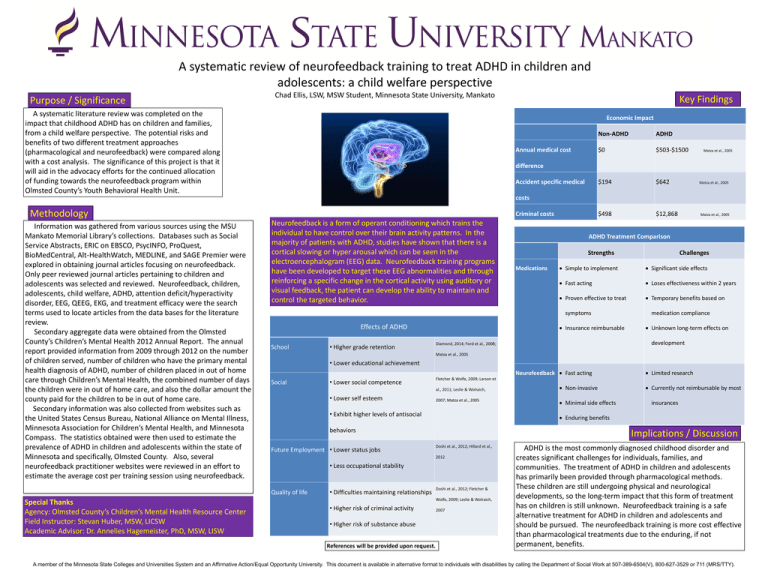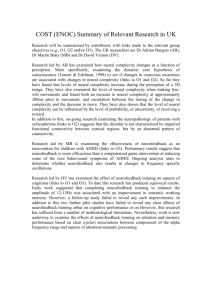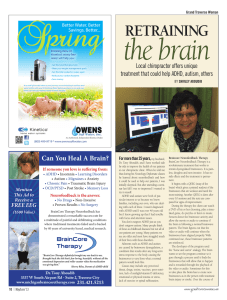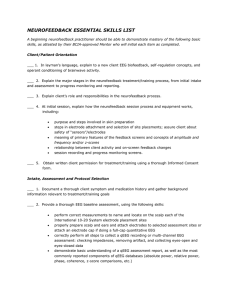A systematic review of neurofeedback training to treat ADHD in... adolescents: a child welfare perspective
advertisement

A systematic review of neurofeedback training to treat ADHD in children and adolescents: a child welfare perspective Purpose / Significance Chad Ellis, LSW, MSW Student, Minnesota State University, Mankato A systematic literature review was completed on the impact that childhood ADHD has on children and families, from a child welfare perspective. The potential risks and benefits of two different treatment approaches (pharmacological and neurofeedback) were compared along with a cost analysis. The significance of this project is that it will aid in the advocacy efforts for the continued allocation of funding towards the neurofeedback program within Olmsted County’s Youth Behavioral Health Unit. Economic Impact Annual medical cost Accident specific medical ADHD $0 $503-$1500 $194 $642 Matza et al., 2005 $498 $12,868 Matza et al., 2005 Matza et al., 2005 costs Criminal costs Neurofeedback is a form of operant conditioning which trains the individual to have control over their brain activity patterns. In the majority of patients with ADHD, studies have shown that there is a cortical slowing or hyper arousal which can be seen in the electroencephalogram (EEG) data. Neurofeedback training programs have been developed to target these EEG abnormalities and through reinforcing a specific change in the cortical activity using auditory or visual feedback, the patient can develop the ability to maintain and control the targeted behavior. ADHD Treatment Comparison Strengths Medications Effects of ADHD School • Higher grade retention Challenges Simple to implement Significant side effects Fast acting Loses effectiveness within 2 years Proven effective to treat Temporary benefits based on symptoms Insurance reimbursable medication compliance Unknown long-term effects on development Diamond, 2014; Ford et al., 2008; Matza et al., 2005 • Lower educational achievement Neurofeedback Fast acting Social • Lower social competence • Lower self esteem 2007; Matza et al., 2005 • Exhibit higher levels of antisocial Doshi et al., 2012; Hillard et al., • Less occupational stability Doshi et al., 2012; Fletcher & Wolfe, 2009; Leslie & Wolraich, • Higher risk of criminal activity • Higher risk of substance abuse References will be provided upon request. Minimal side effects Currently not reimbursable by most insurances Implications / Discussion 2012 • Difficulties maintaining relationships Non-invasive Enduring benefits behaviors Future Employment • Lower status jobs Limited research Fletcher & Wolfe, 2009; Larson et al., 2011; Leslie & Wolraich, Quality of life Special Thanks Agency: Olmsted County’s Children’s Mental Health Resource Center Field Instructor: Stevan Huber, MSW, LICSW Academic Advisor: Dr. Annelies Hagemeister, PhD, MSW, LISW Non-ADHD difference Methodology Information was gathered from various sources using the MSU Mankato Memorial Library’s collections. Databases such as Social Service Abstracts, ERIC on EBSCO, PsycINFO, ProQuest, BioMedCentral, Alt-HealthWatch, MEDLINE, and SAGE Premier were explored in obtaining journal articles focusing on neurofeedback. Only peer reviewed journal articles pertaining to children and adolescents was selected and reviewed. Neurofeedback, children, adolescents, child welfare, ADHD, attention deficit/hyperactivity disorder, EEG, QEEG, EKG, and treatment efficacy were the search terms used to locate articles from the data bases for the literature review. Secondary aggregate data were obtained from the Olmsted County’s Children’s Mental Health 2012 Annual Report. The annual report provided information from 2009 through 2012 on the number of children served, number of children who have the primary mental health diagnosis of ADHD, number of children placed in out of home care through Children’s Mental Health, the combined number of days the children were in out of home care, and also the dollar amount the county paid for the children to be in out of home care. Secondary information was also collected from websites such as the United States Census Bureau, National Alliance on Mental Illness, Minnesota Association for Children’s Mental Health, and Minnesota Compass. The statistics obtained were then used to estimate the prevalence of ADHD in children and adolescents within the state of Minnesota and specifically, Olmsted County. Also, several neurofeedback practitioner websites were reviewed in an effort to estimate the average cost per training session using neurofeedback. Key Findings 2007 ADHD is the most commonly diagnosed childhood disorder and creates significant challenges for individuals, families, and communities. The treatment of ADHD in children and adolescents has primarily been provided through pharmacological methods. These children are still undergoing physical and neurological developments, so the long-term impact that this form of treatment has on children is still unknown. Neurofeedback training is a safe alternative treatment for ADHD in children and adolescents and should be pursued. The neurofeedback training is more cost effective than pharmacological treatments due to the enduring, if not permanent, benefits. A member of the Minnesota State Colleges and Universities System and an Affirmative Action/Equal Opportunity University. This document is available in alternative format to individuals with disabilities by calling the Department of Social Work at 507-389-6504(V), 800-627-3529 or 711 (MRS/TTY).





